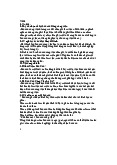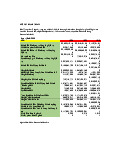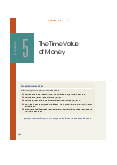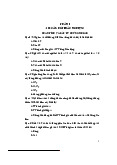





Preview text:
Corporate Finance - Final Exam Review Part A: Multiple Choice
1. According to the capital asset pricing model (CAPM) a security’s expected (required)
return is equal to the risk-free rate plus a premium
A. equal to the security’s beta
B. based on the unsystematic risk of the security
C. based on the total risk of the security
D. based on the systematic risk of the security
2. Which of the following is not a fundamental concept in Corporate Finance? A. Net present value.
B. The relationship between risk and return. C. The business cycle. D. Double-entry book-keeping.
3. The weighted average cost of capital for a firm is the:
A. Discount rate which the firm should apply to all of the projects it undertakes.
B. Rate of return a firm must earn on its existing assets to maintain the current value of its stock.
C. Coupon rate the firm should expect to pay on its next bond issue.
D. Maximum rate which the firm should require on any projects it undertakes.
4. The term "capital structure" refers to:
A. long-term debt, preferred stock, and common stock equity.
B. current assets and current liabilities.
C. total assets minus liabilities. D. shareholders' equity.
5. A single, overall cost of capital is often used to evaluate projects because:
A. It avoids the problem of computing the required rate of return for each investment proposal.
B. It is the only way to measure a firm's required return.
C. It acknowledges that most new investment projects have about the same degree of risk.
D. It acknowledges that most new investment projects offer about the same expected return.
6. This type of risk is avoidable through proper diversification. A. portfolio risk B. systematic risk C. unsystematic risk D. total risk
7. A statistical measure of the degree to which two variables (e.g., securities’ returns) move together: A. coefficient of variation B. Variance C. Covariance D. certainty equivalent
8. An “aggressive” common stock would have a “beta” A. equal to zero B. greater than one C. equal to one D. less than one.
9. A line that describes the relationship between an individual security"s returns andreturns on the market portfolio A. characteristic line B. security market line C. capital market line D. beta
10. According to the capital asset pricing model (CAPM) a security’s expected (required)
return is equal to the risk-free rate plus a premium
A. equal to the security’s beta
B. based on the unsystematic risk of the security
C. based on the total risk of the security
D. based on the systematic risk of the security
11. The span of time within which the investment made for the project will be recovered by
the net returns of the project is known as A. Period of return B. Payback period C. Span of return D. None of the above
12. Projects with __________ are preferred A. Lower payback period B. Normal payback period C. Higher payback period D. Any of the above
13. ___________ on capital is called ‘Cost of capital’. A. Lower expected return B. Normally expected return C. Higher expected return D. None of the above
14. The values of the future net incomes discounted by the cost of capital are called A. Average capital cost B. Discounted capital cost C. Net capital cost D. Net present values
15. Under Net present value criterion, a project is approved if
A. Its net present value is positive B. The funds are unlimited C. Both (A) and (B) D. None of the above
16. The internal Rate of Return (IRR) criterion for project acceptance, under theoretically
infinite funds is: accept all projects which have
A. IRR equal to the cost of capital
B. IRR greater than the cost of capital
C. IRR less than the cost of capital D. None of the above
17. Which of the following criterion is often preferred A. Net present value B. Profitability index C. Internal Rate of Return D. All of the above
18. The project is accepted of
A. if the profitability index is equal to one B. The funds are unlimited
C. If the profitability index is greater than one D. Both (B) and (C)
19. Where capital availability is unlimited and the projects are not mutually exclusive, for the
same cost of capital, following criterion is used A. Net present value B. Internal Rate of Return C. Profitability Index D. Any of the above
20. A project is accepted when
A. Net present value is greater than zero
B. Internal Rate of Return will be greater than cost of capital
C. Profitability index will be greater than unity D. Any of the above
21. With limited finance and a number of project proposals at hand, select that package of projects which has
A. The maximum net present value
B. Internal rate of return is greater than cost of capital
C. Profitability index is greater than unity D. Any of the above
22. A project may be regarded as high risk project when
A. It has smaller variance of outcome but a high initial investment
B. It has larger variance of outcome and high initial investment
C. It has smaller variance of outcome and a low initial investment
D. It has larger variance of outcome and low initial investment
23. Following is (are) the method(s) for adjustment of risks
A. Risk-adjusted Discounting Rate
B. Risk Equivalent Coefficient Method C. Both (A) and (B) D. None of the above Part B: Problem solving Exercise 1 A new project has expected rate of returns 25% and dividend payout of 60%. If EPS this
year expected $4 and a rate of return 15% rate is suitable for this project.
a. What is the sustainable growth rate? b. What is the stock price?
c. What is the present value of growth opportunities? Exercise 2
Two mutually exclusive projects have the cash flow as follows: Project Cash flows Project A Project B 0 -1000 -1000 1 400 495 2 500 495 3 600 495
a. What is the NPV of project A and project B if the opportunity cost of capital is 10%?
b. What is PI of project A and project B if the opportunity cost of capital is 10%?
c. What is the IRR of project A and project B?
d. What is the payback period if the opportunity cost of capital is 10%?
e. Overall, what project would you choose if the opportunity cost of capital is 10%? Exercise 3
Consider the following scenario analysis: Rate of Return Scenario Probability Stocks Bonds Recession 0,20 -10% +14% Growth 0,70 +20% +9% Boom 0,10 +30% +5%
a. Is it reasonable to assume that Treasury bonds will provide higher returns in recessions than in boom?
b. Calculate the expected rate of return and standard deviation for each investment.
c. Consider a portfolio with weights of 60% in stocks and 40% in bonds.
● What is the rate of return on the portfolio in each scenario?
● What are the expected rates of return?




